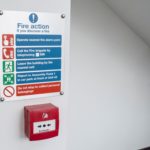David Cload, Projects and Technical Manager at Stocksigns, provides an overview of the current legislation for fire safety signage, including the Health and Safety (Safety Signs and Signals) Regulations 1996 and the BS EN ISO 7010:2019 relating to graphical symbols, safety colours and safety signs.
Staying up-to-date on the latest legal requirements regarding safety signage is crucial for any local authority facilities manager. Not only does it eradicate the risk of fines, but also critically, it serves to diminish the risk of workplace injuries and fatalities. According to the latest report from the Health and Safety Executive (HSE), 142 people were killed in workplace accidents between March 2020 and March 2021 in the UK, proving there is more to be done in terms of alleviating risk for employees across sectors.
Signage has an important role to play in protecting workers, as evidenced by the detailed and ever evolving legislation. In 1996, the Health and Safety (Safety Signs and Signals) Regulations Act was passed, providing signage guidance ‘for employers and duty holders, and others who have responsibility for the control of work sites and premises.’ The Act, which was updated in 2005 and is still in effect today, dedicates an entire section to the importance of signs pertaining specifically to fire safety. At the outset of the section, fire safety signs are defined ‘as a sign (including an illuminated sign or an acoustic signal) which:
- provides information on escape routes and emergency exits in case of fire;
- provides information on the identification or location of fire fighting equipment;
- gives warning in case of fire.’
The document goes on to summarise the use of fire safety signs in buildings and structures, with information regarding the marking and identification of fire fighting equipment. Those responsible for local authority buildings are then given practical advice on where these signs should be displayed; but it is noted that, in many instances, ‘the enforcing authority for fire safety will determine where to locate the signs. In other cases, you should provide signs depending on the outcome of your assessment of risks to health and safety.’
The Act also states that signage should feature wherever hazards have been identified and control measures implemented, in order to alert employees of any ‘residual risk’ that may remain. These signs should be clearly visible, ‘properly maintained […] fixed securely and […] sufficiently large to be clearly seen’.
Current technical standard
When it comes to sign specification for local authority facilities, it is crucial that all signs conform to BS EN ISO 7010 — the current technical standard for signs designed to prevent accidents, protect against fire, evaluate emergencies and provide health hazard information. Providing standardised signage, this legislation was adapted from the previously used BS 5499.
In order to comply with ISO 7010, the design and colour of each safety sign must be manufactured in accordance with ISO 3864-3 and ISO 3864-4, which provide extensive design element detail. Meeting this requirement will ensure clarity and sign consistency.
However, as ISO 7010 was only implemented in 2011, this legislation is being adopted gradually in order to avoid pressurising companies into immediately overhauling all old signage at significant expense. This means that, for now, original BS 5499 compliant signs can still be used, so long as they are not mixed with ISO 7010 compliant signage. This is because consistency is essential. As such, if any pre-existing BS 5499 signs need to be replaced, every sign on the premises must also be updated to ISO 7010.
Failing to meet these criteria can result in heavy fines, especially if an accident occurs. The recent publication of ‘Building a Safer Future’ in 2019 has made the consequences more severe, making the neglect of these laws a criminal offence.
Trusted supplier
With this in mind, specifying fire safety signage from a reliable and established supplier is crucial. The supplier should be able to provide clear guidance and support, demonstrating that the extensive government standards are being met or even exceeded with clear, high quality products. An ideal supplier will also offer a wide portfolio, allowing local authorities to source all their signs from one place, and simplifying the supply process significantly.
Stocksigns, for example is a specialist signage supplier that has delivered a wide variety of bespoke and standardised products since 1955. The company played an instrumental role in developing the original BS 5499 legislation that has since been incorporated into ISO 7010 and, as such, local authority specifiers can rely on Stocksigns to deliver compliant, high-quality products.
Included in its wide portfolio are photoluminescent signs, which self-charge in ambient light and illuminate, offering an ideal solution when workplace conditions inhibit visibility or power failures occur. In addition, the company comprises a knowledgeable team, including a number of dedicated account managers, on hand to help local authority facilities fulfil their signage needs.









